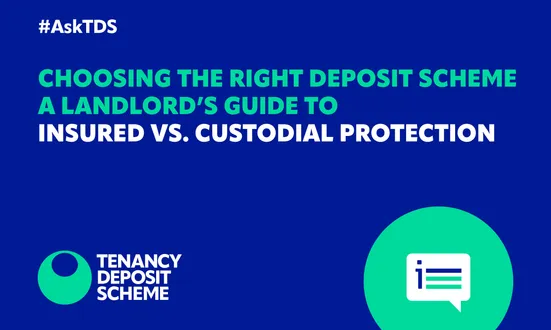As a letting agent, ensuring compliance with deposit protection laws is a key part of your role. You’re not just managing deposits on behalf of landlords, you’re also responsible for ensuring that tenants’ funds are properly safeguarded. Despite deposit protection laws being in place for over 15 years, many agents still face challenges in meeting their obligations, particularly with recent legislative changes.
Here, TDS will provide a breakdown of deposit protection for letting agents, covering legal requirements, best practices, and the role of a Tenancy Deposit Scheme. We’ll also discuss how the Renters’ Reform Bill and Awaab’s Law impact your responsibilities.
Why letting agents must protect deposits properly
Letting agents play a crucial role in deposit protection. If you manage a property and take a deposit from a tenant under an Assured Shorthold Tenancy (AST), soon to transition into periodic tenancies when the renters reform bill [SY1] comes into force, you must protect it in a Tenancy Deposit Scheme within 30 days of receipt. This is a legal requirement, and not doing so can have serious consequences:
- The tenant can take legal action against the landlord, and as their agent, you could be held responsible.
- A court may order the landlord (or you) to return the deposit in full.
- The landlord could be fined up to three times the deposit amount for non-compliance.
- The landlord may be unable to serve notice to regain possession of their property.
Given that deposit protection is a legal obligation, letting agents must ensure all deposits are handled correctly. For government guidance, visit gov.uk.
Which deposit protection scheme
In England and Wales, there are three government-backed deposit protection schemes:
- Tenancy Deposit Scheme
- MyDeposits
- Deposit Protection Service (DPS)
Each scheme offers two options:
- Custodial Scheme: The deposit is held by the scheme for free and returned at the end of the tenancy.
- Insured Scheme: The letting agent or landlord retains the deposit but pays a fee to insure it.
Many letting agents choose the Tenancy Deposit Scheme due to its powerful online platform, integrated API solutions, and best in class tools and discounts through Agent+
Join here, or find out how easy it is to switch!
How letting agents can ensure deposit protection compliance
To remain compliant with deposit protection for letting agents, follow these key steps:
- Register the deposit on time
Within 30 days of receiving the deposit, you must register it with a government-approved Tenancy Deposit Scheme. This is a mandatory legal requirement, and failing to do so could lead to financial penalties.
- Provide the tenant with prescribed information
Once the deposit is protected, letting agents must issue tenants with Prescribed Information. This is written confirmation of:
- The name and contact details of the Tenancy Deposit Scheme used.
- The amount of the deposit and the date it was received.
- How the deposit will be returned at the end of the tenancy.
- The dispute resolution process in case of disagreements.
This information must be provided in writing within 30 days. You can find the prescribed information templates here, and the Tenancy Deposit Scheme leaflet here.
- Keep detailed records
A thorough inventory with photographs at the start of a tenancy is essential in avoiding disputes. The inventory should clearly document:
- The condition of walls, flooring, fixtures, and appliances.
- Any existing wear and tear.
- Meter readings and keys provided to the tenant.
A clear check-in and check-out report will provide solid evidence should any deposit deductions need to be made.
- Be transparent about deductions
If deductions are necessary at the end of the tenancy, it’s crucial to:
- Communicate with tenants about the reasons for deductions. Agents have found that using our Deposit Deductions template to specify the amount you want to subtract from the tenant’s deposit is often successful in reaching an agreement.
- Provide clear evidence, such as inventory photos and receipts for repairs.
- Use the deposit scheme’s Alternative Dispute Resolution (ADR) service if disagreements arise.
The Tenancy Deposit Scheme additionally offers early and self-resolution on both Insured and Custodial platforms, allowing agents, landlords, and tenants to negotiate directly without our involvement unless the situation escalates to a formal dispute.
Recent legislative changes letting agents should know about
Letting agents must stay up to date with evolving legislation to ensure compliance. Two major legal changes will impact deposit protection and tenancy management in the coming years:
The Renters’ Reform Bill
The Renters’ Rights Bill, anticipated to become law after Easter 2025, introduces significant reforms to the private rented sector in England.
1. Removal of Section 21 ‘No-Fault’ evictions
Currently, Section 21 allows landlords to evict tenants without providing a reason, given appropriate notice. The new legislation will abolish this option, meaning landlords must now have a valid, legally specified reason to regain possession of their property.
- You’ll need to rely on specific grounds outlined in the Section 8 of the Housing Act 1988. These include scenarios like intending to sell the property, moving back in, or misconduct such as rent arrears or property damage.
- Evictions will require substantial evidence to support the claimed grounds. For instance, if you plan to sell, documentation like a sales contract may be necessary.
- Depending on the eviction reason, notice periods may vary. For example, evicting a tenant to sell the property or move in yourself requires a four-month notice period.
2. Transition to Periodic Tenancies
Under the new bill, all new Assured Shorthold Tenancies (ASTs) will automatically be periodic, meaning they will roll on a month-by-month basis with no fixed end date. With periodic tenancies, tenants can terminate the tenancy with a minimum of two months’ notice. If you have tenants on a fixed-term contract when the new law takes effect, their tenancy will automatically convert into a periodic tenancy at the end of the fixed term. You don’t need to issue a new agreement, but it’s recommended to review your terms to ensure they align with the new rules. Any new tenancy agreement must comply with the new periodic tenancy rules and agreement should reflect the rolling nature of the tenancy, allowing tenants to give two months’ notice at any time.
3. Regulation of rent increases
To prevent unexpected rent hikes, the Bill stipulates that rent increases can occur no more than once per year and must follow a structured process. Rent adjustments will require serving a Section 13 notice, and tenants will have the right to challenge increases they deem excessive. Landlords will need to ensure rent levels align with local market rates.
Additional provisions from the Renters Reform Bill
- A new binding ombudsman service will be established to resolve disputes between landlords and tenants without the need for court action.
- Landlords will not be able to choose not to rent their properties to those who receive government benefits, or those who have children.
- Landlords will not be able to object to pets being kept on their property without reasonable justification. A landlord must respond to the tenant’s request to keep a pet within 42 days, however, landlords will be able to ask that the tenant purchases suitable pet insurance to cover any damage to their property.
Read more about the bill in detail here.
Awaab’s Law
Coming into force in October 2025, Awaab’s Law requires landlords to address damp and mould issues within strict timeframes. While aimed primarily at social housing providers, private landlords should also ensure their properties remain free of mould and damp hazards to protect tenants health, and avoid potential disputes over deposits for mould related damage.
Letting agents should advise landlords to address maintenance issues promptly to prevent future disputes over deposit deductions for damp-related damage.
TDS have a knowledge-sharing collaboration with DampSmart, aimed to help landlords and tenants gain a clearer understanding of the causes of damp and mould.
About TDS
The Tenancy Deposit Scheme is part of The Dispute Service (TDS), the largest tenancy deposit protection (by value) and resolution service provider in the UK making life easier for tens of thousands of agents, landlords, developers, and millions of tenants and homebuyers. Our award-winning customer service is highly rated on both Trustpilot and Google, and we’re backed by the NRLA. We offer free deposit protection in our Custodial scheme, and the lowest rates for landlords in our Insured scheme.
Other news stories


